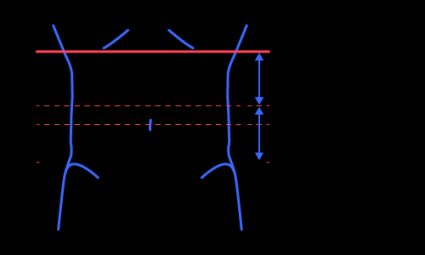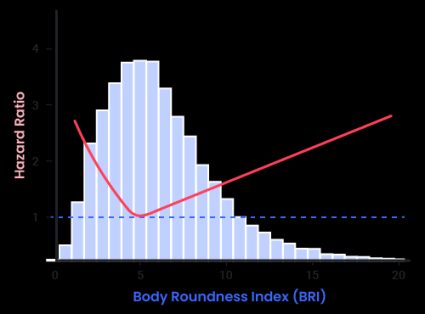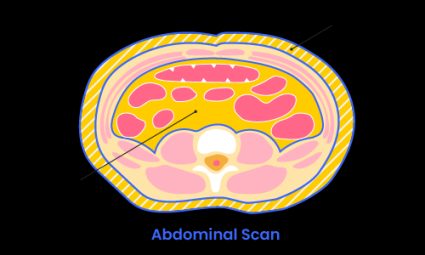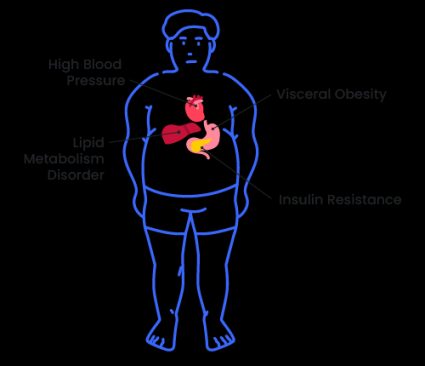BRI Calculator — Body Roundness Index
This calculator helps you to determine your Body Roundness Index (BRI). This alternative to the Body Mass Index (BMI) is currently in the spotlight. It promises to be a more accurate measure of risk factors, which influence your overall health. Calculate your BRI in just a few steps and find out what it says about your health status.
We try our best to make our Omni Calculators as precise and reliable as possible. However, this tool can never replace a professional doctor's assessment. If any health condition bothers you, consult a physician.
What is the BRI and how is it calculated?
The abbreviation BRI stands for Body Roundness Index. You can calculate it using the following formula:
where:
-
— Your waist circumference, expressed in meters; and
-
— Height, expressed in meters.
It measures how much your figure resembles the shape of a ball. The distribution of body fat in your body significantly influences your overall health status and risk factors. It is a known fact that visceral fat increases the risk of cardiovascular disease. That's why the Body Roundness Index was developed to assess the distribution of fat tissue in your body.
How to calculate your BRI using this calculator
A small step-by-step explanation of how to use our tool:
-
Measure your height: Stand next to a wall and measure your height from the bottom of your feet to the top of your head using a ruler or a measuring tape. You might want to ask somebody to help you with this step.
-
Measure your waist circumference: Use a measuring tape to measure your waist circumference. It is measured at the midpoint between the last palpable rib and the top of the iliac crest.

💡 If you do not have a measuring tape, you can use this easy hack to measure your waist circumference: Take a thread or string and place it around the points mentioned above to measure your waist. Mark the point on the thread where you can wrap it once. You can now measure the length of the thread up to the mark you made with your folding rule. Now you have your waist measurement!
-
Type in your values: Just feed the tool with the values obtained. Don’t worry about the units — choose whatever is comfortable for you. Our calculator can convert them all.
-
That’s it! Your results and basic interpretation are ready to review. To find out more, continue reading the next paragraphs.
💡 Curious for more? If you wish, input more information, such as your weight or hip measurement, to immediately obtain more body composition indexes, such as the well-known BMI and waist-hip ratio, which help diagnose abdominal obesity.
What the BRI says about your health status
A study of over 30,000 US adults, conducted by Xiaoqian Zhang MD et al., investigated the link between the BRI and the risk of death by any cause.
The study results showed a U-shaped connection, meaning both high and low BRI results show a higher risk compared to the reference (baseline) group:
- Adults with a BRI below 3.41 were 25% more likely to die from any cause.
- Participants with a BRI between 5.46 and 6.9 faced higher risks.
- Adults with a BRI over 6.91 were 50% more likely to die from any cause.

The U-shaped curve from the study shows that there's a sweet spot for BRI — 3.41 to <5.46. You can see that extremes are not an optimal target.
Another study performed by Julián F. Calderón-García et al. compared the BRI and a Body Shape Index (ABSI) to see if they predict high blood pressure better than the body mass index (BMI), waist circumference (WC) or waist to height ratio (WHtR). The BRI outperformed the ABSI, but there was no conclusive difference between the WC and WHtR. It means that higher BRI values might predict hypertension, which allows you to take action before you get ill.
What does my BRI result mean?
From the findings of the previously mentioned study, you can interpret your result as the following:
-
Your BRI is less than 3.41: This might suggest a moderate increase in health risks, especially if there are other risk factors present.
-
Your BRI is between 3.41 and 4.44: This shows no statistically significant increase in health risks.
-
Your BRI is between 4.45 and 5.45: This generally indicates a low risk for health problems related to visceral obesity.
-
Your BRI is between 5.46 and 6.91: This might suggest a moderate increase in health risks, especially if other risk factors are present.
-
Your BRI is greater than 6.91: This is often linked to a higher risk of health problems related to visceral obesity, such as heart disease, diabetes, and metabolic problems. You might want to discuss this result with a physician and consider a lifestyle change.
BRI vs. BMI
The world-famous BMI is calculated based on your height and weight using the following formula:
where:
-
— Your weight, expressed in ;
-
— Height, expressed in meters (); and
-
— Body Mass Index, expressed in .
BMI (body mass index) | BRI (body roundness index) |
|---|---|
Doesn’t take into account body composition | Does consider body composition (as muscle is more dense than fat) |
Focuses on your weight | Focuses on your waist circumference |
You can state a diagnosis by looking at BMI | You can’t diagnose a disease by looking only at BRI |
💡 If you want to compare your BRI results with your BMI, you should check out our BMI calculator.
Dangers of visceral fat
You might wonder why we compare a human's shape to a ball instead of any other shape. You already know that a bigger waist circumference implies the silhouette becoming rounder. The thing is, your abdomen — your mid-axis — protects important organs: the liver, pancreas, kidneys, etc. That means excessive fat in this area will also influence those organs, compared to, e.g., excessive fat on your hip area (so-called "pear body shape").
Excessive visceral fat tissue is responsible for, among others:
-
Producing certain hormones that distort your hormonal balance (in both men and women);
-
Producing inflammatory substances (we know more and more about how many chronic diseases are actually based on inflammation);
-
Promoting insulin resistance, prediabetes, and diabetes;
-
Certain cancers;
-
High blood pressure, which leads to kidney disease; and
-
You can also link obesity with mental health problems, such as depression and anxiety.

The Deadly Quartet: Metabolic Syndrome Risks
Obesity is the biggest risk factor for developing a metabolic syndrome and, therefore, a diagnosis that should be taken seriously. Metabolic syndrome comprises five risk factors that can contribute to heart disease, diabetes, stroke, and other health issues. It is diagnosed with the presence of at least three of the following risk factors:
-
Visceral obesity — over 40 in (100 cm) waist for men, over 35 in (89 cm) for women, or waist to hip ratio over 0.85 for women and 0.9 for men — regardless of the waist circumference;
-
Triglycerides fasting above 150 mg/dL or receiving treatment for dyslipidemia;
-
HDL concentration lower than 40 mg/dL (men) or less than 50 mg/dL (women) or receiving treatment for dyslipidemia;
-
Systolic blood pressure over 130 mmHg, or diastolic over 85 mmHg or more, or receiving treatment for hypertension; and
-
Blood sugar level above 100 mg/dL (fasting) or receiving treatment for insulin resistance, prediabetes, or diabetes.

To simplify matters, it can be summarized as a deadly quartet consisting of obesity, high blood pressure, lipid metabolism disorder, and insulin resistance.
❗ Possible complications of obesity include non-alcoholic fatty liver disease or cardiovascular secondary diseases such as a heart attack or stroke.
The treatment of metabolic syndrome begins with challenging your daily habits. It’s necessary to be supervised by a doctor, but most of your treatment happens at home. Some of the most important lifestyle changes are:
-
Watch your diet. Incorporate more plant-based foods, veggies, nuts, legumes. Pass on the sweets, meat, and salty snacks.
-
Get moving. According to the WHO (World Health Organization), adults should engage in at least 150 minutes of physical activity per week. This includes walking, gardening, vigorous cleaning, etc.
-
Cut out the stimulants. Cigarettes, e-cigarettes, and alcohol are all linked to chronic diseases. Remember, you can use pharmacotherapy and psychological support to help you fight the addiction.
💡 Did you know you can actually measure your nicotine addiction? Check the Fagerstrom test for nicotine dependence calculator.
Understanding your health status with body measures
Does it mean that if your BRI is in an “okay” range, you have nothing to worry about? We wish it that way, but it is not.
Remember that this index, like any other body or health index, is just a single value that describes your current health state. It is the same as diagnosing hypertension with just one blood pressure measurement or not being able to interpret a blood test result without knowing the patient and their history.
You can consider the BRI value as one building block of your overall health. It might give you a general idea of your body composition, but it doesn’t determine whether you will fall ill in the future. There are a bunch of factors you should take into account when dealing with cardiovascular diseases. They fall into non-modifiable and modifiable categories.
Non-modifiable risk factors are:
- Age;
- Biological sex;
- Race; and
- Family history.
Whereas modifiable risk factors are:
- Your diet composition;
- Your physical activity;
- Use of stimulants — mainly tobacco and alcohol;
- Blood pressure;
- Your stress reaction and response, and the social support you give and take;
- Biochemical indexes, for example, hypercholesterolemia, high blood glucose, CRP, uric acid; and
- Presence of other diseases — e.g., obesity, chronic inflammatory diseases, mental health disorders.
Unfortunately, it is also possible to develop a cardiovascular disease without any prior risk factors. If you have a high or low BRI, you should consider a lifestyle change. Of course, this is something that is meant to be discussed with a physician since this tool cannot assess your overall health. This calculator is merely a tool designed to provide a more accurate measurement of body composition and associated health risks compared to the traditional Body Mass Index (BMI).
✅ We have designed this calculator to increase awareness about what you can act upon — modifiable risk factors. If you’re concerned about your BRI result, don’t hesitate to ask your healthcare provider for help. And if you want to act immediately, . Good luck!